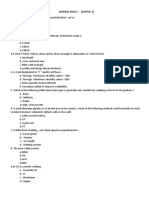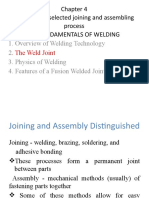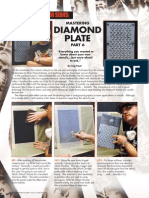0 ratings0% found this document useful (0 votes)
426 viewsTECHNOLOGY3 Answer
This document contains a series of multiple choice questions related to welding processes and quality control. Some key topics covered include welding symbols, preheat requirements, non-destructive testing methods like radiography and magnetic particle inspection, and weld quality factors like penetration and defects. The questions are intended to test knowledge of welding specifications, responsibilities of different roles, and industry standards.
Uploaded by
ابومحمد الكنانيCopyright
© © All Rights Reserved
Available Formats
Download as DOCX, PDF, TXT or read online on Scribd
0 ratings0% found this document useful (0 votes)
426 viewsTECHNOLOGY3 Answer
This document contains a series of multiple choice questions related to welding processes and quality control. Some key topics covered include welding symbols, preheat requirements, non-destructive testing methods like radiography and magnetic particle inspection, and weld quality factors like penetration and defects. The questions are intended to test knowledge of welding specifications, responsibilities of different roles, and industry standards.
Uploaded by
ابومحمد الكنانيCopyright
© © All Rights Reserved
Available Formats
Download as DOCX, PDF, TXT or read online on Scribd
You are on page 1/ 7
TECHNOLOGY QUESTIONS (SET-3)
1. Who should have access to WPQRS?
a. NDT operators
b. Welding inspectors
c. Welders only
d. Welding engineer
2.Who determines what the correct preparation(root gap ,root face , included angle )should be ?
a. The welding engineer
b. The welding supervisor
c. The welder will decide
d. The inspector will recommended what is suitable
3. How is preheat for tack welds during assembly and fit up determined ?
a. By the welders as they have extensive knowledge
b. The fabrication specification/WPS will give the requirements
c. The fabrication drawings will give all the information
d. Any temperature will do as it is only tack weld
4. Why is it sometimes necessary to preheat the base material before welding ?
a. To remove oil and reuse
b. To remove moisture from inside the material
c. To prevent the possible risk of cracking
d. Not required if using cellulosic electrodes as these will provide enough heat
5. Which of the following would not be require before welding ?
a. The welding consumables
b. The welder’s qualification
c. calibration of welding equipment
d. The workshop humidity
6. Which BS EN stands is used for welding symbols?
a. BS EN 970
b.BS EN 287
c.BS EN 22553
d.BS EN 4515
7. Who responsible for site safety?
a. Site quality engineer
b. Welding supervisor
c. An Approved safety engineer
d. Every one
8. Who has the responsibility of ensuring the welder is using correct polarity duringwelding ?
a. The welder and welding inspector
b. store man and the welder
c. Welding engineer
d. Q/A department
9.When would you measure the minimum preheat temperature?
a. on completion of each pass
b. Immediately prior to commencing the first pass and subsequent passes
c. when the welding is completed
d. between run and the next run to it
10. During root welding which of the following would be the main cause of excess penetration?
a. The root gap is too small in a accordance with WPS
b. Preheat not used
c. The current is too high
d. Root face is too high
11. The welder had increased the voltage on the SAW welding set, what would be the effect on the
weld?
a. NO effect
b. The weld width would be narrower
c. The penetration will be increased
d. The weld width would be wider
12. What is the maximum OCV allowable to initiate an arc when using AC current ?
a. 1000 V
b. 10 V
c.90V
d. 900 V
13. Why is the OCV capped at this voltage setting?
a. To save electricity
b. To prevent exploding of the consumables
c. allows smooth transition into welding voltage range
d. To reduce the risk of fatality
14. What information would be recorded as a minimum on a completed production weld
a. Size and type of electrode
b. Welding supervisor’s name
c. welders ’s identification, date and weld number
d. Welding inspector’s name
15.Why would visual inspection of the excess weld material at the bottom of a cross country pipeline be
important ?
a. It is the most difficult area to weld
b. It is the dirtiest part of the pipe as it is near to the ground
c. Welders always forget to weld the bottom
d. It is the most difficult area to radiograph
16.Why is it essential to clean the excess weld metal on completion of the production weld ?
a. So it can be ready for painting
b. To remove an y rust
c. To ensure it is suitably clean for welding inspection and NDT
d. To remove slag from the undercut
17.To assess surface of a weld for indirect inspection, the distance from the surface to the eyes should
be a maximum of
a. 200mm
b. 600mm
c.60mm
d. 6000 mm
18 .What is the recommended minimum range of illumination required by BS EN 970 for inspection of a
welded surface ?
a.90 to 125 lux
b.150 to 250 lux
c.350 to 500 lux
d.35 to 50 lux
19.Who should select the specific welds for NDT, to cover the 10% contractual percentage required by
the specification/code
a. Anyone can select the welds as it is a random choice
b. The welder has he knows which welds ar likely to produce the least defects
c. This will be referenced in the inspection and test plan
d. nobody , as welding is carried out to a high standard the use of percentage NDT of no real
value
20.In a transverse weld tensile test, if the break was in the weld material , the sample would be
a. Rejected
b. Acceptable if the UTS is equal to or greater than the specified UTS plate
c. retested
d. Acceptable if the UTS is between 80-90 % of the specified UTS of the plate
21.in a welder qualification testing of 45 mm plates, why are side bends used instead of roote and face
bends
a. They are easier to produce
b. the testing equipment cannot handle thick root/ face bends
c. Roots defects are not important for welder qualifications
d. They give more accurate indications
22.Which of the following is not a quantitative test?
a. Root bend
b. Macro hardness
c. Charpy
d. Tensile
23.When examining a completed bend test, the angle of the bend was found to be 185°.the testing
specification calls for the sample to have been formed through 180°
a. They should be acceptable as the standard refers to minimum forming angle
b. They bends should be considered as failed
c. New bends should be produced and bent to 180° then re-examined
d. they should be rejected as the angle is not close enough to be acceptable
24.In a cross joint tensile test, the following observations were made; specimen width :20mm, material
thickness :20mm, max load 180KN break position: parent plate , what is the UTS?
a. 45KN/MM2
B.450N/mm2
c. 39 KN/mm2
d. 39N/mm2
25.Charpy impact test showing rough torn surface after the completed test , this would indicate which
type of failure
a. fatigue
b. Ductile
c Fatigue to ductile
d.Brittle
26.A butt weld has been made by MMA in a 50 thick impacted tested steel plate ..The welding electrode
used as a basic type 5mm diameter, the measured running parameters for one runs was 250 amps 24
volts using DC+ve polarity and a ROL of 180 mmper minute , what woulde be the arc energy?
a. In sufficient information given to the calculate arc energy
b. 1.9 kj/mm
c. 1.87kj/mm
d. 2.0kj/mm
27. What is a typical ARC voltage setting when welding with TIG(GTAW)process in AC?
a. 90 V
b.24-26 V
c.10-12 V
d. 70-90 V
28. When MMA welding what will be the effect on the weld if the power source was changed from AC to
DC -ve?
a. None
b. Higher deposition rate
c .It would slightly increase the depth of penetration
e. The arc would become unstable
29. When using multiple SAW arc systems (twin wires etc.), the arc often has different polarities or use
all AC rather than DC polarity, this is to
a. Prevent arc blow between the arcs
b. To maximize productivity
c. To reduce the risk of fatality
d. Makes it easier to initiate the arc
30. Which is the mode of metal transfer for the TIG(GTAW)welding process?
a. Spray transfer
b. Globular transfer
c. Dip transfer
d. None of the above
31. Which of the following process uses a flat characteristic?
a. MAG(GMAW)
b. Oxy –fuel gas welding
c. Resistance spot welding
d. SAW using more than 1000 amps
32. When welding medium carbon steel plates over 100 mm in thickness would the basic electrodes
require any pre treatment before use?
a. None if they were in vacuum pack opened 8 hours prior to use
b. none if they were in a sealed vacuum pack prior to use
c. Heat 500°c for 2 hours if used outside
d. Baked at 50° for 4 hrs prior to use
33.Which of the following defects is usually associated with the MAG(GMAW) welding process when
using DIP transfer ?
a. Centerline crack
b. Lack of sidewall fusion
c. spatters
d. Tungsten inclusion
34.What would be the most likely SAW flux type for welding medium carbon steel which requires impact
testing?
a. Cellulosic
b. Rutile
c. Fused
d. Agglomerated
35.With which of the following NDE process is it possible to detect the both surface and slight sub
surfaces defects up to 2 mm below the surface
a. visual
b. Dye- Penetrant
c. Magnetic particle using DC
d. Magnetic particle using AC
36.For MPI using the prods methods, which of the following statement is true
a. it may cause arc damage on the specimen material surface
b. It requires lower operations there for easier
c. It can e used with ferritic and non ferritic materials
d. it is quicker than using a yoke type electromagnet
37.Which of the following commonly used radioactive isotopes has the longest half-life?
a. Iridium 192
b.Cobalt 60
c. Thulium 170
d.Ytterbium 169
38.Half-life is a term describe
a.the penetrating ability of a gamma source
b.Half the total time a gamma source will be useful
c. The time taken by gamma source to reduce its strength by half
d. The rate of decay of an x-ray tube
39.What is the greatest disadvantage of a radiographic inspection?
a. Its inability to size defects accurately
b. The physical size of the equipment
c. the skill level of the operators
d. The harmful effects of ionizing radiations
40.Which of the following defects are unlikely to be detected by normal radiographic techniques
a. inter granular corrosion cracking
b.porosity
c.slag
d.lack of penetration
41.Weld decay occurs in which of the following steel types
a. Carbon/manganese
b. Low alloy
c. Any stainless steel
d. Austenitic stainless steel
42. The temperature at which chromium carbide is formed is in the range
a. 350°-550 C
b. 550-800 °C
c. 800-1050°C
d.1050 – 1500 °C
43.Weld decay cause which of the following problem
a. A reduced resistance to corrosion
b, A lower tensile strength
c. The toughness is reduced
d. The hardness will increase
44.Weld decay can be minimized by specifying a steel with
a. Higher carbon level
b. Higher chromium level
c. lower carbon level
d. lower Chromium level
45.Post weld heat treatment is used to reduce
a.residual stress
b. Normalising
c. Quench and temparing
d. Solution treatment over 1000°C
46. In GMAW MIG/MAG welding, which mode of metal transfer uses frequencies in cycle time?
a. pulse transfer
b. spray transfer
c. dip transfer
d. globular transfer
47. What is meant by the term duty cycle?
a. How long a welder can weld for in a given period
b. The amount of time the electrode is being used
c. The amount of time a welding machine can be used
d. The amount of electricity being consumed
48. what is the purpose of a cross joint tensile test? To check?
a. for lack of side wall fusion
b. the strength of the haz
c. The strength of the weld
d. the strength of the joint
49. Why is the post weld heat treatment carried out?
a. to reduce residual stress
b. to reduse distortion
c. reduse stress raisers
d. welding times are faster and cost effective
50. What is the main difference between EN and ASME welding procedure?
a. Bend requirements
b. NDT requirements
c. Tensile requirements
d. Visual Acceptance
51. The term manual welding is used when the welder controls?
a. wire speed
b. arc length
c. transfer mode
d. burns off rate
52. What do the first 2 numbers in MMA electrode represent to en classification?
a. tensile strength
b. impact value
c. recovery rate
d. welding position
53. Pure argon is used with the MIG process to weld which material?
a. all materials
b. steels
c. stainless steels
d. aluminum
54. If preheating is decreased, which of the following would be most greatly affec ted?
A. tensile strength
b. distortion
c. hardness
d. toughness
55. In medium carbon steels a fast cooling rate would most likely cause which of the following?
a. corrosion cracking
b. lamellar tearing
c. susceptible microstructure
d. solidification cracking
56. Which standard is used for European welding procedure qualification?
a. EN 22553
b. EN 15614
c. EN 499
d. EN 287
57. Sequential welding is referred to which of the following?
a. Fatigue line
b. residual stress
c. distortion
d. not associated with any of the above
58. Which MMA electrode is commonly used for vertical down welding?
a. low hydrogen
b. basic
c. cellulosic
d. rutile
59. What unit measurement is used for charpy impact testing?
a. joules
b.N/mm2
c. kj
d. vpn
60.Included angle of V joint
a.30
b.35
c.120
d.70
1-D 11-D 21-D 31-A 41-D 51-B
2-A 12-C 22-A 32-B 42-B 52-A
3-B 13-D 23-A 33-B 43-A 53-D
4-C 14-C 24-B 34-D 44-C 54-C
5-D 15-A 25-B 35-C 45-A 55-C
6-C 16-C 26-D 36-A 46-A 56-B
7-D 17-B 27-C 37-B 47-C 57-C
8-A 18-C 28-B 38-C 48-D 58-C
9-B 19-C 29-A 39-D 49-A 59-A
10-C 20-B 30-D 40-A 50-B 60-D
You might also like
- Welding Inspection Level 2 - Paper 5 Technology - Exercise IV100% (2)Welding Inspection Level 2 - Paper 5 Technology - Exercise IV10 pages
- ''Technology Examination Questions (Multi-Cohice Exam - 1)No ratings yet''Technology Examination Questions (Multi-Cohice Exam - 1)4 pages
- Technology Multiple Choice Exam Få Fò - HWP100% (3)Technology Multiple Choice Exam Få Fò - HWP39 pages
- WISS CSWIP Technology Multiple Choice Exam 1 Version A 18 August 2014No ratings yetWISS CSWIP Technology Multiple Choice Exam 1 Version A 18 August 201410 pages
- B. The Amount of Time The Electrode Is Being Used100% (1)B. The Amount of Time The Electrode Is Being Used4 pages
- Casing Clean Up Tools Description: Casing Scraper Junk Basket Junk SubNo ratings yetCasing Clean Up Tools Description: Casing Scraper Junk Basket Junk Sub3 pages
- How To Apply Touch Up Paint On Plastic PartsNo ratings yetHow To Apply Touch Up Paint On Plastic Parts2 pages
- List of Enlisted Vendors Civil /electrical / Miscellaneous WorksNo ratings yetList of Enlisted Vendors Civil /electrical / Miscellaneous Works61 pages
- Production and Operation Management ProjectNo ratings yetProduction and Operation Management Project16 pages
- New Cold End Sizing Process For Ensuring Dimensional Precision On Both Ends of Line PipesNo ratings yetNew Cold End Sizing Process For Ensuring Dimensional Precision On Both Ends of Line Pipes1 page
- Welding Joint Design & Welding Symbols - Chapter #5No ratings yetWelding Joint Design & Welding Symbols - Chapter #514 pages
- Artool 6-Craig Fraser Mastering Diamond Plate - 1259611059No ratings yetArtool 6-Craig Fraser Mastering Diamond Plate - 12596110593 pages
- Welding Inspection Level 2 - Paper 5 Technology - Exercise IVWelding Inspection Level 2 - Paper 5 Technology - Exercise IV
- ''Technology Examination Questions (Multi-Cohice Exam - 1)''Technology Examination Questions (Multi-Cohice Exam - 1)
- WISS CSWIP Technology Multiple Choice Exam 1 Version A 18 August 2014WISS CSWIP Technology Multiple Choice Exam 1 Version A 18 August 2014
- Casing Clean Up Tools Description: Casing Scraper Junk Basket Junk SubCasing Clean Up Tools Description: Casing Scraper Junk Basket Junk Sub
- List of Enlisted Vendors Civil /electrical / Miscellaneous WorksList of Enlisted Vendors Civil /electrical / Miscellaneous Works
- New Cold End Sizing Process For Ensuring Dimensional Precision On Both Ends of Line PipesNew Cold End Sizing Process For Ensuring Dimensional Precision On Both Ends of Line Pipes
- Welding Joint Design & Welding Symbols - Chapter #5Welding Joint Design & Welding Symbols - Chapter #5
- Artool 6-Craig Fraser Mastering Diamond Plate - 1259611059Artool 6-Craig Fraser Mastering Diamond Plate - 1259611059

























































































